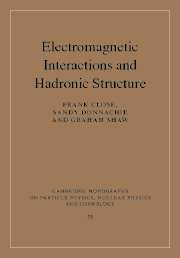Book contents
- Frontmatter
- Contents
- List of contributors
- Preface
- 1 Quark models of hadrons and issues in quark dynamics
- 2 Elastic form factors
- 3 Electromagnetic excitations of nucleon resonances
- 4 Meson radiative decays
- 5 Intermediate-energy photoproduction
- 6 Chiral perturbation theory
- 7 Spin structure functions
- 8 Diffraction and colour dipoles
- 9 Generalized parton distributions
- 10 Quark–hadron duality
- 11 Colour transparency
- Index
2 - Elastic form factors
Published online by Cambridge University Press: 15 August 2009
- Frontmatter
- Contents
- List of contributors
- Preface
- 1 Quark models of hadrons and issues in quark dynamics
- 2 Elastic form factors
- 3 Electromagnetic excitations of nucleon resonances
- 4 Meson radiative decays
- 5 Intermediate-energy photoproduction
- 6 Chiral perturbation theory
- 7 Spin structure functions
- 8 Diffraction and colour dipoles
- 9 Generalized parton distributions
- 10 Quark–hadron duality
- 11 Colour transparency
- Index
Summary
Afundamental goal of nuclear and particle physics is to understand the structure and behaviour of strongly interacting matter in terms of its fundamental constituents. An excellent model of atomic nuclei is that they consist of protons and neutrons interacting by the exchange of pions. This is the view of the nucleus studied at low resolution. Hence, protons, neutrons and pions can be considered as the building blocks of the nuclei, a description valid for almost all practical purposes. Nonetheless, these building blocks are themselves composite particles, and studying their electromagnetic structure has been one of the main research thrusts of electron scattering.
The first studies of the electromagnetic structure of nucleons using energetic electron beams as probes began in the 1950s with the work by Hofstadter et al [1]. The experimental goal in these early measurements and in those that followed was to understand how the electromagnetic probe interacts with the charge and current distributions within nucleons. The embodiment of these interactions are the electromagnetic form factors. These quantities could be calculated if a complete theory of hadron structure existed. In the absence of such a theory, they provide an excellent meeting ground between experimental measurements and model calculations.
These nucleon form-factor measurements become increasingly difficult at high Q2 because the cross section is found to fall as ∼ Q-12 at high Q2 and the counting rates drop correspondingly. However, experimental techniques have progressed greatly since the early experiments and, together with the exploitation of spin degrees of freedom, have produced an impressive data set out to large Q2.
Information
- Type
- Chapter
- Information
- Electromagnetic Interactions and Hadronic Structure , pp. 39 - 76Publisher: Cambridge University PressPrint publication year: 2007
